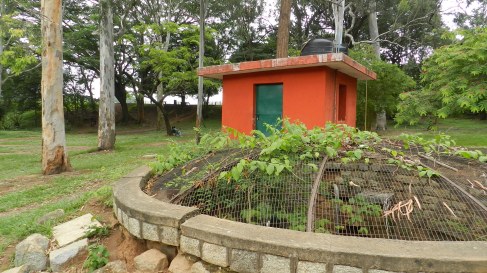
The parks in our city – Waters ancient and modern
July 24, 2012Watering the garden – the Lalbagh story
S.Vishwanath
Even for the garden city with its many parks Lalbagh is iconic. Spread over 240 acres with 1854 species of plants on display it is a botanical dream. Started in 1760 by Hyder Ali as a private garden it was spread over just 40 acres when it began. Dr Francis Buchanan in his famous travelogue in 1800 writes “ The gardens are extensive and divided into square plots divided by walks the sides of which are ornamented with fine Cypress trees…..want of water is the principal defect of these gardens for in this arid country everything during the dry season must be artificially watered. The garden of Tippoo is supplied from 3 wells, the water of which is raised by the ‘capilly’ or leather bag, fastened to a cord passing over a pulley and wrought by a pair of bullocks which descend on an inclined plane. “
The open well at Lalbagh – Circa 1760 ? Did it have a Capilly ?
So it was that on a Saturday when one was invited to visit the Lalbagh to help look at the water situation that one was excited. The small tank then serving Lalbagh has now expanded to cover 20 acres. The Bangalore Development Authority has invested over 2.5 crores in expanding and improving the tank. Storm water feeders to the tank are now regularized and cleaned from cow-dung and animal waste which once used to flow in. A small sewage treatment plant has been set up at one side of the park where domestic sewage from surrounding areas is trapped, treated and stored in a reservoir for watering the park. Up-to 1.5 million litres per day can be treated and made available to the park. The cost of the treated water for Lalbagh comes at an economical Rs 15 per kilo-litre. If there is excess then treated waste-water can be led into the lake for storage to further recharge the groundwater.
9 bore-wells have been drilled to supplement the treated waste-water for use to water the park. These have varying depths but the deepest is about 370 feet.
What was however a discovery was the 3 wells in the original 40 acre campus. Were these the original wells from 1760? Most probably yes but more investigations are due. The wells were unused and some had waste strewn in them. It is however definitely possible to clean them up and de-silt them. All the wells had water and the water was at 15 to 20 feet thanks most probably to the large lake up-stream . The stone lining was intact except the parapet needed repairs.
It would be wonderful if the wells could be cleaned up and brought into life. Wells need the least amount of energy to pump water since the head to which water is to be lifted is less and therefore have the lowest cost for water. To use well water makes economic and ecological sense.
The old tank at Lalbagh – now rejuvenated and made larger
As a water heritage even the ‘Kapile’, the ‘Yeta’ and the Persian Wheel can be fitted to the wells to remind us of a glorious water heritage. This will be another attraction of Lalbagh apart from its lovely flowers, plants and trees.
Lalbagh shows how a verdant green park can cater to its water needs by investing in smart sustainable solutions. Preserving and enhancing a lake, using treated waste water, using groundwater and reviving open wells is a mini integration of water management.
There is of course much more of a need to monitor the quality of the lake water, ensure that the sewage treatment plant works constantly and well, that the hydro-geology and groundwater table is mapped and understood and that shallow aquifer sources are integrated better into the water system.
All these water structures could be made more informative and display boards informing local citizens and visitors of how these systems work can only enhance water literacy. That is water wisdom.




Leave a comment